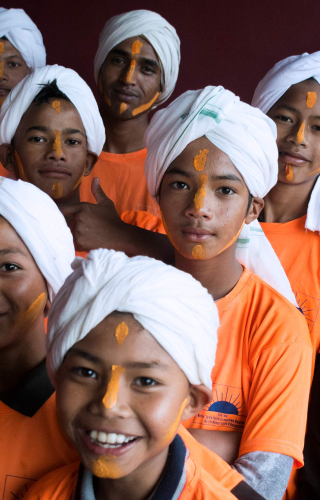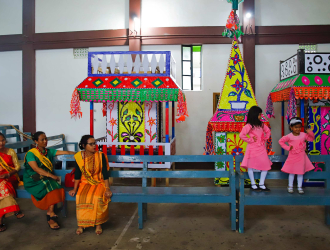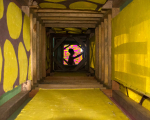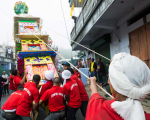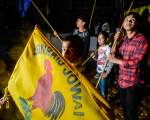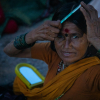“We’re all ghosts. We all carry, inside us, people who came before us.”
– Liam Callanan, The Cloud Atlas
I have been fascinated by the works of Sebastiao Salgado, Mary Ellen Mark, David Alan Harvey, Susan Meiselas, Philip Blenkinsop, Alec Soth and Pablo Bartholomew; photographers who used visual imagery to unravel stories of remote cultures, peoples, languages and rituals. After I graduated from Jamia Millia Islamia University, New Delhi, my creative appetite drew me towards Northeast India, which is home to hundreds of tribes with a rich, but often unappreciated history, heritage and culture.
Subsequently, I worked in Meghalaya, doing projects with the Khasi and Garo tribes. I had not interacted with Meghalaya’s third major tribe, the Jaintias (also known as Pnar), but I was intrigued about their annual Behdienkhlam festival. Jaintias give foremost importance to man’s relationship with environment, ancestor worship, clan relations, maintaining social harmony and upholding cultural traditions. These values are collectively expressed during the Behdienkhlam festival, which I decided to document as part of the Frames Photography Grant.
I arrived at Jowai, in West Jaintia Hills, much in advance of the festival. A major challenge I faced on arrival at Jowai was the inclement weather. In June-July, the monsoon season is at its peak in Meghalaya. I had to make sure all my equipment was waterproofed securely at all times. It rained continuously and the sky was overcast throughout my stay. I walked in muddy terrain for many kilometers, particularly when events took place on a hill on the outskirts of Jowai town. Due to the weather, I had expected few people to attend the ceremony, but, to my surprise, men of all ages had reached the hill as early as 4 am, and had already begun the ritual. They were overwhelmed at my presence, appreciating the effort made by an outsider to be a part of their festivities.
As an outsider, with limited knowledge of the Jaintias, their language and their religious beliefs, I spent a considerable amount of time trying to make conversation with the clan heads, priests, youth and women of the community to gain understanding about the festival from their perspective. I wanted to understand the genesis of Behdienkhlam and also the framework of the indigenous Niamtre religion, because the two are interwoven.
Behdeinkhlam is derived from two Pnar words: Behdein meaning ‘to drive away’ and Khlam meaning ‘plague’. Thus, Behdienkhlam has its origins in the mists of time when an epidemic of cholera spread across the Jaintia hills. To stop the plague, four sisters carried the longest tree trunk from the forest and buried the evil plague in a pool of mud. These four sisters, named Ka Doh, Ka Bon, Ka Wet and Ka Tein, are believed to be the matrilineal ancestors of Jowai’s present-day population of Jaintias. Each locality prepares a decorative tower-like structure called a ‘rath’. These are carried in a procession to an artificial mud-pool (aitnar) for symbolic immersion. While the men perform the sacrifices and outdoor rituals, the women prepare offerings for their clan ancestors and pray to U Blai (supreme deity) to protect themselves and mother nature from evil spirits, plague and disease.
Due to the nature of Behdeinkhlam’s origin, the festival stresses the relationship humans have with the natural world. Jaintias worship one supreme deity known as U Blai Wa Booh Wa Thoo, who is omnipresent, omniscient and omnipotent. U Blai is the creator of everything in the universe, and the initiator of all events beyond human understanding. U Blailives in soorkep (version of heaven) but his presence is felt by the people within their natural surroundings and through events that transpire with them or their families. Because U Blai is omnipresent, the worship of U Blai does not require any idol, image, or temple dedicated to him. Instead, the Jaintias consider the forest and mother nature sacred. Other than U Blai, the pantheon of the Jaintias consist of several other male and female deities, and sacrifices and oblations are made to them during Behdienkhlam.
Behdienkhlam is also an occasion for families to get together to enact rituals related to the indigenous religion known as Niamtre, which means ‘own religion’ in the Pnar language. This stress on originality is important to the Jaintia people, implying Niamtre is not borrowed from other religions, nor is it manmade. Instead, it is gifted directly from their God. The foundation of Niamtre is based around observation of three commandments: Tip bru-tip blai (know men-know God),Tip kur-tip kha (know your maternal and paternal relatives or know your kinsmen); Kamai ia ka hok (earn righteousness); and Im ha ka hok ka sot (live always by what is right and always speak the truth).
Tip bru-Tip blai stresses on right behaviour and respecting fellow human beings, and plays a significant role in maintaining cordial relationship between human beings and also between humans and God, while the Tip kur-tip kha concept upholds close affinity between maternal and paternal clans. A man who follows this principle finds no hurdles in earning righteousness. Ancestral worship also plays an important part in the religious life of the Jaintias, and the veneration of past wisdom remains pivotal to their value systems, which they pass within the community members through rituals and group activities in festivals like Behdienkhlam. This was even more significant in the past, because the Jaintias didn’t have a written script till the nineteenth century, and festivals were the only way to transmit collective memories and oral narratives within the tribe.
Living in the fast-paced modern age has made many of us question what is it that we, as humans, truly value? The answer doesn’t lie far from the one Jaintias have always believed in. In many ways, then, Behdienkhlam upholds ancient wisdom where the natural world is held sacred and its spirit is nurtured, cherished and celebrated in its original form. I feel that this concern is of utmost importance in our present times, when humanity is faced with rampant environmental destruction and exploitation of wildlife and natural resources.
In the end, I would like to acknowledge the extensive work done by Dawmanchuh Lamar on Pnar culture. His research paper has been a reference point for me to understand the significance of numerous traditions I enthusiastically chose to be a part of.
